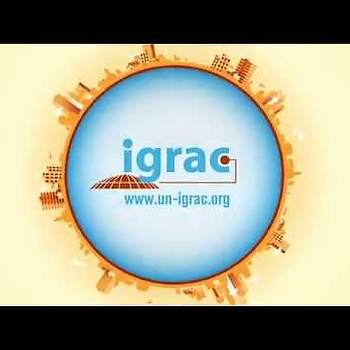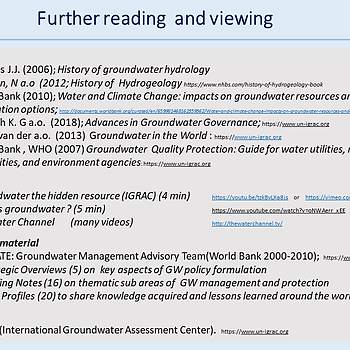- Strong related to groundwater are the terms Hydrology, Hydrogeology, Groundwater hydrology and Geohydrology.
- Hydrology is the science dealing with the occurrence, circulation, distribution, and properties of the waters of the earth and its atmosphere.
- Hydrogeology (hydro- meaning water, and -geology meaning the study of the Earth) is the area of geology that deals with the distribution and movement of groundwater in the soil and rocks of the Earth's crust (commonly in aquifers).
- Groundwater hydrology and Geohydrology refer more to the study of the flow of groundwater and the engineering aspects like designing and drilling of water wells.
- Yet the terms Groundwater hydrology, Geohydrology and Hydrogeology are often used interchangeably.
Further reading and Viewing
Books
- De Vries J.J. (2006); History of groundwater hydrology
- Howden, N a.o (2012; History of Hydrogeology https://www.nhbs.com/history-of-hydrogeology-book
- World Bank (2010); Water & Climate Change: impacts on GW resources & adaptation options;
- Villholth K. G a.o. (2018); Advances in Groundwater Governance;
- Gun J. van der a.o. (2013) Groundwater in the World;
- World Bank , WHO (2007) Groundwater Quality Protection Guide;
- Goulburn-Murray Water (2015) \Groundwater Terms and definitions. Document Number: 2977263.
Videos
- Groundwater the hidden resource (IGRAC) (4 min)
- What is groundwater? (5 min)
- The Water Channel (many videos) http://thewaterchannel.tv/
GWMATE material
- GWMATE: Groundwater Management Advisory Team(World Bank 2000-2010);
- Strategic Overviews (5) on key aspects of GW policy formulation;
- Briefing Notes (16) on thematic sub-areas of GW management and protection;
- Case Profiles (20) to share knowledge acquired and lessons learned around the world.
IGRAC and RWSN (libraries)

